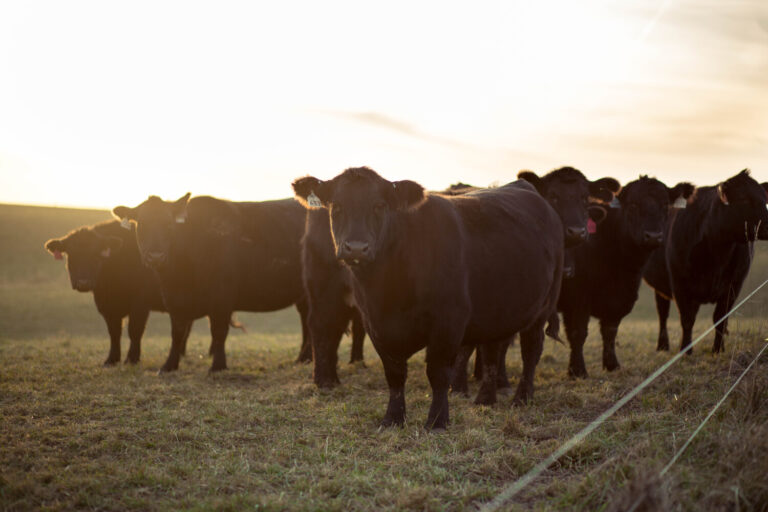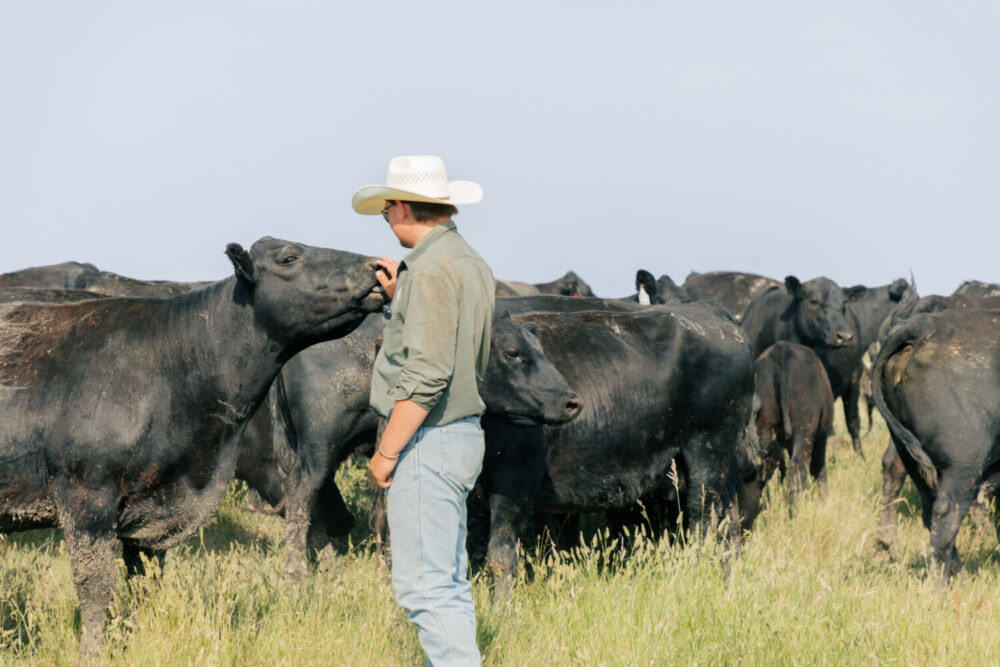
Implementing High-Density Grazing
June 2024
Doing more with less is nothing new for agricultural producers. As urban sprawl overtakes farmland, producers need to preserve existing grasslands for long-term production and food security.
For more than 20 years, Noble Research Institute Director of Ranches, Outreach and Partnerships Hugh Aljoe has advocated for regenerative practices that care for the land, grass and livestock. One hallmark of this philosophy is high-density grazing, also known as mob grazing.
“High-density grazing is the practice of intentionally grazing livestock in higher concentrations than normal to manage soil, forages and livestock production of a specific area,” he explained. Thought is given to the stage of maturity, recovery, desired residual, season of use, growing conditions, and kind and stage of production of the grazing livestock, among other factors.
It exists in stark contrast to basic rotational grazing, where producers move cattle through only a few pastures and provide some pasture recovery. In a high-density grazing system, producers frequently move cattle among existing pastures, with usually four to eight pastures in the rotation. Some ranches find themselves applying the strategy in 30 pastures or more. Aljoe said he considers that ultra-high-density grazing, especially when livestock are moved daily or multiple times a day.
High-density grazing improves efficiency
Aljoe said many people interested in mob grazing are trying to achieve a higher stocking rate. However, he cautioned producers that this goal is not instantly attainable.
“Often, the best way to begin to make land improvements and increase pasture productivity is to adjust your stocking rate down and get your grazing management in order first using existing pastures,” he said. “It is not unusual for us to see people that move in two or three years back to the same stocking rate. But now they’ve got a program where you’re actually beginning to build the production naturally.” Once you have developed some comfort with rotational grazing in existing pastures, subdividing those pastures to smaller grazing units is the next step. Going from a simple rotation where cattle are moved to a fresh pasture every week to daily allocations with greater stock densities usually improves the number of grazing days per acre by 25% or more, with the same stocking rate and same amount of forage production.
His team aims to manage their high-density grazing system so cattle can graze year-round, and the Noble ranches have accomplished this. Depending on where you live in the U.S., this lofty goal may take several years to achieve, but Aljoe said there are practical ways to check progress over time.
“Hay is primarily reserved for periods of inclement weather and short-term feeding events such as weaning. In most grazing environments, hay should not be used to increase stocking rate. Stocking rate should be adjusted with growing conditions. This means you must track your grazing days, your animal unit days and the recovery in between,” he said. “You want to be able to go out there and be sure that, over time, these pastures are trending upward.”
When cattle graze for a shorter duration in a smaller space, the competition for desirable grass teaches them to graze more uniformly. In a well-managed rotation, the cattle will graze forages more evenly before moving. With managing for appropriate after-graze residuals and recovery, Aljoe said the more productive plants get healthier and begin to dominate the landscape — leading to a greater carrying capacity over time.
Additionally, he recommended noting the depth of the dark topsoil. That highly organic layer at the soil surface should get deeper with each passing year.
From the soil up
Aljoe said the effectiveness of high-density grazing begins with what is below the surface. While monocultures are popular in production agriculture today, he argued they are not the best for long-term soil health and sustainability.
“If you think about nature, there are no monocultures in healthy ecosystems,” he said. “Because of our desire to try to manage the land, we like to put something there that we can have control over.”
This often leads producers to amend the soil and inadvertently destroy some of the existing biology. He said the more diverse the soil biology, the better quality the forages will be. In other words, by maintaining adequate ground cover and allowing organic material back into the soil, increased soil health and water retention will ultimately ensure more nutrient-dense forage.
That is where high-density grazing comes into play. If mob grazing is done properly by adapting to varying scenarios, Aljoe said a producer can expect to grow diverse grasses in a hurry during the wet growing season. As conditions become dry, he said producers should be more intentional to keep from overgrazing and protect the soil and plant communities.
Grazing plans aren’t a one-size-fits-all solution, so taking the time to identify the best grazing practices for each operation is critical. And grazing plans have to be adapted for changing conditions on the ranch. Considering forage types and plant cover, season of use, and rainfall or moisture conditions is a big part of that.
“Ultimately, we want a functional ecosystem where water goes into the soil rapidly, and doesn’t run off,” he said. “We want to make sure we have, to the extent we can, as much soil cover and plant diversity as we can within our ecosystem that we’re managing.”
Herd management considerations
If a producer already checks their cattle a couple of times per week, implementing high-density grazing may not require much additional labor.
“It is more about timeliness, not the amount of time,” Aljoe said.

In this system, cattle herds are consolidated. They learn how to move through the pastures easily after a few moves and can be trained with an electric fence. Aljoe said it doesn’t necessarily require more labor, but it does require more planning and timely management to move cattle before the forage is grazed too short and to provide adequate recovery.
A producer can access an abundance of resources online (like Greg Judy Regenerative Rancher) and in print (like Management-Intensive Grazing by Jim Gerrish) to help determine the appropriate pasture size and adapt to forage conditions for this grazing approach. The amount of time cattle spend in each pasture depends on the desired post-graze residual height, how quickly they graze the pasture, the number of pastures to be grazed in the rotation, and the rate of recovery. This requires an adaptive approach.
“We have got to be thinking about how we are going to apply our management relative to the situation we have to work with and realize stock density should be adaptive,” he said. “It should not be prescriptive.”
Large or small, Aljoe advised producers to start with a “safe-to-learn” area. This allows producers to get a feel for what this new grazing strategy may look like, accomplish some early successes, and make mistakes on a small area before expanding to the entire acreage. He also suggested beginning on a productive area, when there is abundant forage for a defined period of time — preferably multiple weeks. This makes observation and management easier.
“Water is the most limiting factor on most properties,” he pointed out. “If you can strategically locate your water around your pastures … that’ll return your investment the quickest.”
Aljoe said cattle in most environments will comfortably graze out about a half mile from water, which can be used as an advantage in high-density grazing. By controlling where the water sources are, you can encourage animals to graze different areas of the pasture and increase productivity in turn.
Rest and regrow
Once the infrastructure, adjusted stocking rate, and carrying capacity are in place and the soil biology is being considered, Aljoe said to begin working through management of the rest period. A general rule is to only allow cattle to graze 30% to 40% of a plant before moving them to maximize regrowth during the growing season.
“It’s sort of like mowing your yard,” he explained. “If you go out there and mow the grass at 2 inches (5 centimeters), you may not have to be out there next week. But if you mowed at 4 inches (10 centimeters), you probably need to mow it again the next weekend.”
In short, the more left behind and the longer the rest period between grazing events, the more rapidly the pasture will recover during the growing season.
The name of the game is using high-density grazing strategies to foster the nutrient cycling that leads to healthier grass and cattle.
“What we’ve got to do is follow the same processes,” Aljoe concluded. “Top graze, move on, top graze, move on, top graze, and allow for the recovery. Because what they don’t graze, we want laid down to eventually become part of the organic matter. This will then cover the surface and add to the retention of water.”
An alternative option
While grazing is ideal for soil health, there are certain situations when producers may find it impossible. For example, areas without access to water or without fencing are not good candidates for high-density grazing. Fields previously seeded as monocultures aren’t a match for it either.
While those areas can slowly be converted back into native or more naturalized pasture, Aljoe said there is an option in the meantime. If hay is needed in the environment, growing hay or making haylage on a portion of these areas allows producers the opportunity to have reserves from their land to deliver high-quality nutrition to their herd during winter or other unexpected weather events.
Remember, haying is a nutrient-mining activity as the hay is rarely fed on the pastures they were baled on. The objective for grazing-land soil health is to manage so you can graze as many acres as possible for as many days as possible each year and minimize the hay required due to an inflated stocking rate.
By using a more appropriate cutting height of greater than 6 inches (15 centimeters), producers can encourage regrowth on the forage stand to maximize its overall contribution to the herd and minimize the number of days the soil surface is exposed. Fortunately, there are mowers and balers on the market to fit a variety of situations. Being strategic about where hay is delivered also has merit.
“Take that hay and feed it on those sites that really need improved organic matter,” Aljoe said. “Allow that material they don’t eat to be spread and trampled across the soil surface, feeding the organisms in the soil to jumpstart your nutrient cycling.”
Over time, those areas will grow more higher-quality forage because the organic matter is returning to the soil and enhancing grazing land soil health.
To find the best equipment to achieve your herd management goals, contact your local Vermeer dealer today.
Information noted above was gathered from a third party who was advised his/her experience might be featured in marketing materials. This article contains third-party observations, advice or experiences that do not necessarily reflect the opinions of Vermeer Corporation, its affiliates or its dealers. Individual results may vary based on care and operation of machine and crop and field conditions, which may adversely affect performance.
Vermeer Corporation reserves the right to make changes in engineering, design and specifications; add improvements; or discontinue manufacturing at any time without notice or obligation.
Equipment shown is for illustrative purposes only and may display optional accessories or components specific to their global region.
Please contact your local Vermeer dealer for more information on machine specifications.
Vermeer and the Vermeer logo are trademarks of Vermeer Manufacturing Company in the U.S. and/or other countries.
© 2024 Vermeer Corporation. All Rights Reserved.

